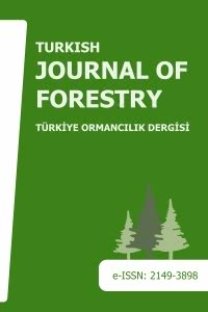Yoğunluğun güney sarıçam (Pinus taeda L.) ağacının Mod I kırılma davranışı üzerine etkisi
Kırılma, Kırılma tokluğu, Güney sarıçam, Özgül kırılma enerjisi, Başlangıç eğimi
Influence of density on Mode I fracture behavior of southern yellow pine (Pinus taeda L.) wood
Fracture, Fracture toughness, Southern yellow pine, Specific fracture energy, Initial slope,
___
- Ashby, M.F., Easterling, K.E., Harrysson, R., Maiti, S.K., 1985. The fracture and toughness of woods. Proceedings of the Royal Society of London A: Mathematical, Physical and Engineering Sciences, 398(1815): 261–280.
- ASTM-D 2395-14, 2014. Standard test method for density and specific gravity (relative density) of wood and wood-based materials. Annual Book of ASTM Standards, USA.
- ASTM-E 399-09, 2009. Standard test method for linear-elastic plane-strain fracture toughness KIC of metallic materials. Annual Book of ASTM Standards, USA.
- Conrad, M.P.C., Smith, G.D., Fernlund, G., 2003. Fracture of solid wood: A review of structure and properties at different length scales. Wood and Fiber Science, 35(4): 570–584.
- Fruhmann, K., Reiterer, A., Tschegg, E.K., Stanzl-Tschegg, S.S., 2002. Fracture characteristics of wood under mode I, mode II and mode III loading. Philosophical Magazine A, 82(17-18): 3289-3298.
- Konukcu, A.C., Quin, F., Zhang, J., 2021. Effect of growth rings on fracture toughness of wood. European Journal of Wood and Wood Products, 79(6): 1495-1506.
- Kretschmann, D.E., Green, D.W., Malinauskas, V., 1991. Effect of moisture content on stress intensity factors in southern pine. Proceedings of International Timber Engineering Conference, 2-5 September, London, England, pp. 3.391-3.398.
- Majano, M.A.M., Hughes, M., Fernández-Cabo, J.L., 2010. A fracture mechanics study of thermally modified beech for structural applications. 11th World Conference on Timber Engineering (WCTE 2010), 20-24 June, Trentino, Italy, pp. 2103-2108.
- Ohuchi, T., Hermawan, A., Fujimoto, N., 2011. Basic studies on fracture toughness of sugi and acoustic emission. Journal of the Faculty of Agriculture Kyushu University, 56(1): 99-102.
- Patton-Mallory, M., Cramer, S.M., 1987. Fracture mechanics: A tool for predicting wood component strength. Forest Products Journal, 37(7/8): 39-47.
- Petterson, R.W., Bodig, J., 1983. Prediction of fracture toughness of conifers. Wood Fiber Science, 15(4): 302-316.
- Reiterer, A., Sinn, G., Stanzl-Tschegg, S.E., 2002. Fracture characteristics of different wood species under mode I loading perpendicular to the grain. Materials Science and Engineering: A, 332(1-2): 29-36.
- Reiterer, A., Tschegg, S., 2002. The influence of moisture content on the mode I fracture behaviour of sprucewood. Journal of Materials Science, 37(20): 4487-4491.
- Schniewind, A.P., Ohgama, T., Aoki, T., Yamada, T., 1982. Effect of specific gravity, moisture content and temperature on fracture toughness of wood. Wood Science, 15(2): 101-109.
- Smith, I., Landis, E., Gong, M., 2003. Fracture and Fatigue in Wood. John Wiley and Sons, England.
- Tukiainen, P., Hughes, M. 2016. The effect of temperature and moisture content on the fracture behaviour of spruce and birch. Holzforschung, 70(4): 369-376.
- Valentin, G., Adjanohoun, G., 1992. Applicability of classical isotropic fracture mechanics specimens to wood crack propagation studies. Materials and Structures, 25(1): 3-13.
- Vasic, S., 2000. Applications of fracture mechanics to wood. PhD Dissertation, The University of New Brunswick, Canada.
- Wu, Y., Shao, Z., Wang, F., 2012. Study on wood fracture parallel to the grains based on fractal geometry. International Journal of Fracture, 176(2): 163-169.
- Yoshihara, H., Usuki, A., 2011. Mode I critical stress intensity factor of wood and medium-density fiberboard measured by compact tension test. Holzforschung, 65(5): 729-735.
- ISSN: 1302-7085
- Yayın Aralığı: Yılda 2 Sayı
- Başlangıç: 2000
Hizmet amaçlı işletilen ormanlarda optimal kuruluşların belirlenmesi
Sertleştiricinin orta yoğunluklu lif levhanın bazı fiziksel ve mekanik özelliklerine etkisi
Nur DİKTAŞ BULUT, İsmet DAŞDEMİR
Doğu çınarı ( Platanus orientalis L.) yapraklarının uçucu bileşenleri
Ebru Hatice TIĞLI KAYTANLIOĞLU, Hüseyin FAKİR, İlhami Emrah DÖNMEZ
Uzaktan algılama teknikleri ile altyapı sistemlerinin konumsal analizi: Burdur Havzası örneği
Barbotinia oraniensis (Barbotin, 1964) (Hymenoptera: Cynipidae) türünün Türkiye’den ilk kaydı
Musa TATAROĞLU, Yusuf KATILMIŞ
Sefa Süleyman TAŞDELEN, Mehmet Arif ÖZYAZICI
Yoğunluğun güney sarıçam (Pinus taeda L.) ağacının Mod I kırılma davranışı üzerine etkisi
